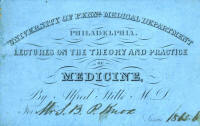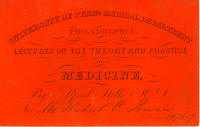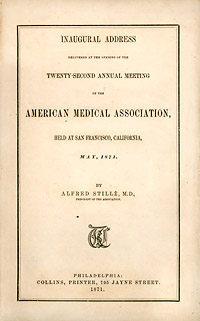Alfred Stille, M.D.


Click image to enlarge
Go to lecture card display
Go to the book in this collection by Dr. Stille
Professor
of the Theory and Practice of Medicine, 1864-1884
|
Alfred
Stillé (1813-1900)
A.B. 1832, M.D. 1836, LL.D. (hon.) 1889
President of the Zelosophic Society
Member of Phi Beta Kappa
Professor of the Theory and Practice of
Medicine, 1864-1884
Physician
Medical Educator, author, reformer
Secretary and President of the American
Medical Assn.
President of the College of Physicians
Death date: Sep 24, 1900
Place of death: Philadelphia, PA
Birth date: 1813
Place of birth: Philadelphia, PA
Type of practice: Allopath
States and years of licenses:PA, 1881
Medical school(s): University of Pennsylvania School of
Medicine, Philadelphia, 1836, (G)
Journal of the American Medical Association Citation: 35:834;
(M)
|
Dr. Stillé's first
employment as a physician came even before his graduation from Penn's
Medical School, when in 1835 he became a house physician at Philadelphia
Hospital. After his return from Europe, Stillé served as a resident
physician at Pennsylvania Hospital from 1839 to 1841; he also began
building a respectable private practice. His first teaching position
came in 1845 with an appointment as a lecturer on pathology and the
practice of medicine at the Philadelphia Association for Medical
Instruction, a medical school offering courses only in the summer.
During the 1840s, he was also a leader of the movement promoting reform
in medical education which led to the establishment of the American
Medical Association in Philadelphia in 1847. As secretary of the AMA's
organizing committee and then of the AMA itself, Stillé played a central
role in gaining the support of Jefferson Medical College and the
University of Pennsylvania Medical School.
Stillé continued to
build his professional stature over the next few years. He gained
appointments as visiting physician at St. Joseph's Hospital in 1849 and
then, from 1854 to 1859, as professor of the theory and practice of
medicine at the medical department of Pennsylvania Medical College; he
also served during the Civil War as a surgeon at the Satterlee Hospital
in Philadelphia. His publications during these decades included the
first general pathology book in English,
Elements of General Pathology published in 1848, and
Therapeutics and Materia Medica, published in 1860. By 1859, Stillé
was named president of the Pathological Society of Philadelphia, and
three years later was named president of the Philadelphia County Medical
Society.
Stillé's
appointment as professor of the theory and practice of medicine at the
University of Pennsylvania Medical School came in 1864, just as the
school was about to embark on the
major reform and expansion that would
reestablish the medical school as a leader in American medical
education. Stillé played a role in the addition of sciences to the
curriculum in 1865, the move to the larger West Philadelphia campus in
1874, and in 1876, the increase of the course of study from two to three
years and the development of fixed salaries for professors. During this
years on the Penn medical faculty before his 1884 retirement, Stillé
became president of the AMA in 1871, vice-president of the Centennial
Medical Commission in 1876, and then President of the College of
Physicians in 1883. (Penn Biographies)
Alfred Stillé was
born in Philadelphia October 30, 1813, the son of merchant John Stillé
and his wife Maria Wagner. Stillé began his college years at Yale, but
after he was expelled during his sophomore year for participating in a
student rebellion, he enrolled at the University of Pennsylvania.
Entering the
College in 1830, Alfred Stillé graduated with an A.B. degree in 1832.
During his undergraduate years at Penn, he was president of the
Zelosophic Society and a member of Phi Beta
Kappa. After graduation from the College, Stillé went on to earn his
medical degree from Penn in 1836. Alfred Stillé's younger brother,
Moreton Stillé (1822-1855), would also study at Penn, graduating from
the College of the University of Pennsylvania in 1841 and then earning
his M.D. from Penn's Medical School in 1844.
 Alfred
Stillé's medical education included, but was not limited to lectures at
Penn's Medical School; Stillé also studied anatomy under William Wood
Gerhard and Caspar Wistar Pennock at Philadelphia Hospital (later
Philadelphia General Hospital). Gerhard and Pennock had studied in Paris
under Pierre-Charles-Alexandre Louis, who emphasized the connection
between symptoms and postmortem examinations and also the importance of
observation and medical statistics. During the 1836 typhus epidemic in
Philadelphia, Stillé joined Gerhard and Pennock in their application of
these principles in a study of 120 patients, resulting in Gerhard's
classic paper which made the distinction between typhus and typhoid
fever. As a result of this experience, Stillé journeyed to Paris to
study medical diagnostics under Louis from 1836 until 1839. Alfred
Stillé's medical education included, but was not limited to lectures at
Penn's Medical School; Stillé also studied anatomy under William Wood
Gerhard and Caspar Wistar Pennock at Philadelphia Hospital (later
Philadelphia General Hospital). Gerhard and Pennock had studied in Paris
under Pierre-Charles-Alexandre Louis, who emphasized the connection
between symptoms and postmortem examinations and also the importance of
observation and medical statistics. During the 1836 typhus epidemic in
Philadelphia, Stillé joined Gerhard and Pennock in their application of
these principles in a study of 120 patients, resulting in Gerhard's
classic paper which made the distinction between typhus and typhoid
fever. As a result of this experience, Stillé journeyed to Paris to
study medical diagnostics under Louis from 1836 until 1839.
Since
American medical education during the first half of the nineteenth
century lacked unified standards and
opportunities for hands-on training, Stillé greatly appreciated the
rigorous training demanded of French physicians. When he returned to
Philadelphia, he became a key leader for
reform of the American medical curriculum.
Stillé's successes as a leader of this reform movement would eventually
result in his appointment to a chair in the University of Pennsylvania
Medical School, but this recognition was not immediate.
Despite his
leadership in raising the standards of medical education, Stillé soon
lagged behind his peers in his acceptance of the latest key scientific
and medical research. His publications from the 1870's and 1880's reveal
that he viewed both the germ theory of disease and also the new science
of bacteriology as mere speculation. In his teaching, he did not accept
laboratory medicine, but continued to emphasize clinical observation,
medical statistics and hospital practices.
In 1841, Alfred
Stillé married Caroline Christiana Barnett, of Boston, who became the
mother of his three children. Caroline died in 1899, after being
institutionalized for over fifty years because of mental illness. Six
weeks after her death, Stillé married Katherine Blackiston, aged 59.
Stillé died at his home at 39th and Spruce Streets in Philadelphia the
following year, at the age of 87..
STILLE. Alfred,
physician, was born in Philadelphia, Pa., Oct. 30, 1813. son of John and
Maria Stille. His father, a leading merchant of Philadelphia
(1790-1812), was descended from one of the first Swedish colonists on
the Delaware river. His mother was a descendant of Tobias Wag- uer,
chancellor of the University of Tubingen ш 1658, and of one of his
descendants who was a Lnth eran missionary in Pennsylvania about the
middle of the eighteenth century. Dr. Stille was educated in the
classical school of Wylie & Engles, Philadelphia, from which he entered
Yale in Í828. In 1830 be was transferred to the University of
Pennsylvania, where he took the degree of A.B. in 1832.
The following
year he began the study of medicine, matriculated at the University of
Pennsylvania and was graduated M.D. in 1836. Immediately afterwards he
served as a dispensary physician, and then as a resident physician of
the Philadelphia Hospital for a period of six months, after which he
spent two years in Europe, chiefly in medical study under some of the
most eminent teachers of London, Edinburgh, Dublin and Paris. On his
return he was a resident physician of the Pennsylvania Hospital for two
years, and then, in 1841, began private practice. From 1844 to 1851 he
lectured for the Philadelphia Association for Medical Instruction. In
1861 lie revisited Europe, spending the greater part of his time in
Vienna, where he attended the lectures of Oppolzer, Skoda and Hebra. He
held the chair of theory and practice of medicine at the Pennsylvania
Medical College from 1854 to 1859, and ш i lie University of
Pennsylvania for twenty years, and, on resigning it in 1884, was made
professor emeritus. On the organization of St. Joseph's Hospital he was
elected one of its physicians, and served it for upwards of twenty
years.
During the civil war he was one of the physicians of Satterlee
Hospital, Philadelphia ; for a time he held a similar appointment in the
University Hospital, and for six years (1865-71) was a visiting
physician and clinical lecturer in the Philadelphia Hospital. Although
for nearly fl fty years engaged in the practice of his profession, Dr.
Stille devoted himself assiduously to teaching and writing. In 1844, in
collaboration with Dr. J. Forsyth Meigs, he translated Andral's
"Pathological Hœmatology." In 1848 his treatise on "General Pathology"
appeared. In 1880 he made numerous additions to the second edition of
Wharton and Stillé's "Medical Jurisprudence," the medical part of which
in the first edition had been prepared by his brother, Dr. Moretón
Stille. In the same year appeared the first edition of his "
Therapeutics and Materia Medica." of which the fourth edition was
published in 1878. In 1367 his monograph on " Epidemic Meningitis " was
published. In 1879 was issued the first edition of the " National
Dispensatory," prepared by Dr. Stille in collaboration with Prof. John
M. Maisch. Of this work the fifth edition was issued in 1894. In 1885
his work on " Cholera " appeared. It was an enlarged edition of a
lecture that was published in 1873. Besides the degrees in conree
received by Dr. Stille, he was made honorary A.M. by Yale in 1849; LL.D.
by Pennsylvania College (Gettysburg) in 1859. and by the University of
Pennsylvania in 1889. He was a member of the Philadelphia Medical
Society (1834); La Société Médicale d'Observation. Paris (1836); fellow
of the College of Physicians of Philadelphia (1842), and subsequently
chairman of its library committee, secretary, vice-president, censor and
president; he was an original member and secretary of the American
Medical Association (1847); member of the Philadelphia County Medical
Society (1849), and its president (1863); member and president of the
Pathological Society of Philadelphia (1859-63): member of the U. S.
sanitary commission
|
|